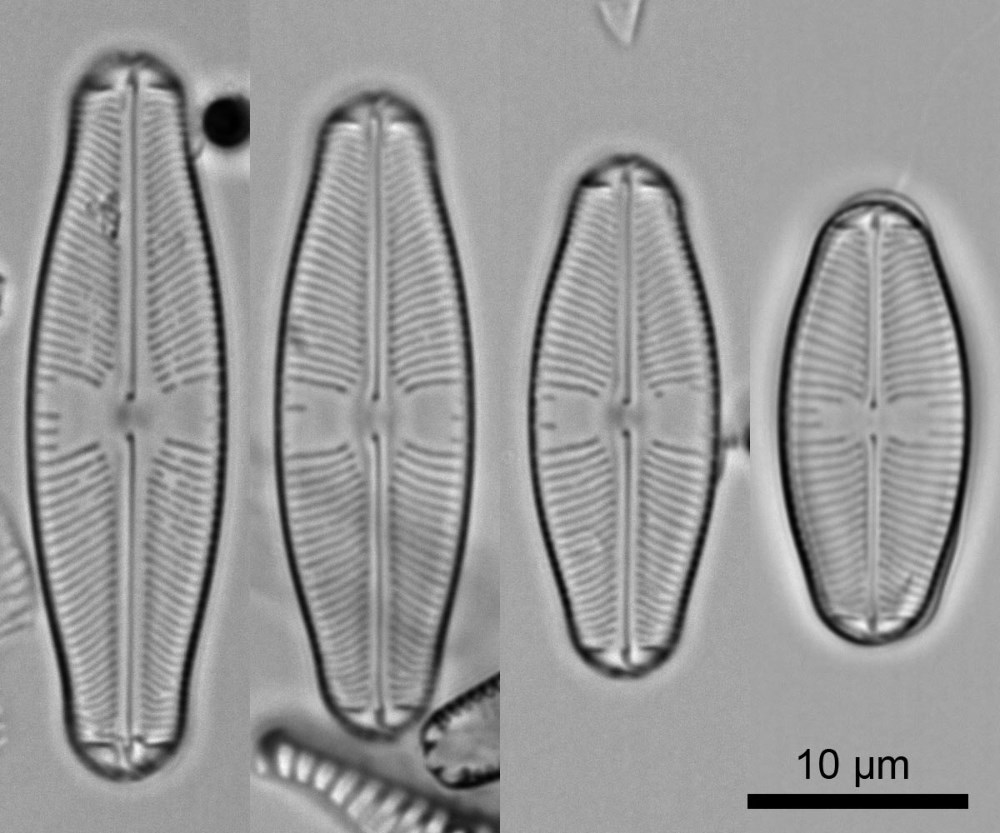Sellaphora obesa D.G.Mann & M.M.Bayer; 2004; 473
Key references
Mann D.G., McDonald S. M., Bayer M.M., Droop S.J.M., Chepurnov V.A., Loke R.E., Ciobanu A., Du Buf J.M.H. 2004. The Sellaphora pupula species complex (Bacillariophyceae): morphometric analysis, ultrastructure and mating data provide vidence for five new species. Phycologia. 43(4): 459-482.
Morphology
Size
Width 20-53 µm, width 8.1-10.0 µm, ratio pole width/maximum width ca. 1:1.8 (UK population, Mann et al. 2004).
Shape
Valves elliptical to narrowly elliptical with rostrate ends.
Symmetry
Isopolar, bilaterally symmetrical.
Striae
Radiate at the centre and convergent (or occasionally parallel in smaller valves) at the poles; 17.9-21.3 in 10 µm (UK populations, Mann et al. 2004).
Axial area
Narrow linear, straight.
Central area
Rectangular or slightly bow-tie-shaped subfascia; somewhat irregular, bordered by approximately alternate long and short striae.
Raphe
Simple, straight, thread like, central raphe endings are slightly expanded externally, deflected slightly towards the primary side, internally also deflected towards the primary side.
Other features
Polar silica bars appear perpendicular to apical axis or a little reflexed; resembles a larger, coarser (e.g. a lower striation density), more robust version of S. pupula; the absence of ghost striae and shape of central area separate S. obesa from S. auldreekie and S. lanceolata.
Width 20-53 µm, width 8.1-10.0 µm, ratio pole width/maximum width ca. 1:1.8 (UK population, Mann et al. 2004).
Shape
Valves elliptical to narrowly elliptical with rostrate ends.
Symmetry
Isopolar, bilaterally symmetrical.
Striae
Radiate at the centre and convergent (or occasionally parallel in smaller valves) at the poles; 17.9-21.3 in 10 µm (UK populations, Mann et al. 2004).
Axial area
Narrow linear, straight.
Central area
Rectangular or slightly bow-tie-shaped subfascia; somewhat irregular, bordered by approximately alternate long and short striae.
Raphe
Simple, straight, thread like, central raphe endings are slightly expanded externally, deflected slightly towards the primary side, internally also deflected towards the primary side.
Other features
Polar silica bars appear perpendicular to apical axis or a little reflexed; resembles a larger, coarser (e.g. a lower striation density), more robust version of S. pupula; the absence of ghost striae and shape of central area separate S. obesa from S. auldreekie and S. lanceolata.
Literature
References are given in chronological order.
Reference |
Citation |
|---|---|
| Mann D.G., McDonald S. M., Bayer M.M., Droop S.J.M., Chepurnov V.A., Loke R.E., Ciobanu A., Du Buf J.M.H. 2004. The Sellaphora pupula species complex (Bacillariophyceae): morphometric analysis, ultrastructure and mating data provide vidence for five new species. Phycologia. 43(4): 459-482. | Morphology; Taxonomy; Description; Type Illustration; |
Similar Species
Similar species not published on this website:
This page should be cited as:
Mann D. G. Sellaphora obesa D.G.Mann & M.M.Bayer; 2004; 473. In: Jüttner I., Carter C., Cox E.J., Ector L., Jones V., Kelly M.G., Kennedy B., Mann D.G., Turner J. A., Van de Vijver B., Wetzel C.E., Williams D.M..
Freshwater Diatom Flora of Britain and Ireland. Amgueddfa Cymru - National Museum Wales. Available online at https://naturalhistory.museumwales.ac.uk/diatoms/browsespecies.php?-recid=4428. [Accessed:
].
Record last modified: 27/12/2020


